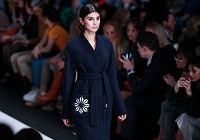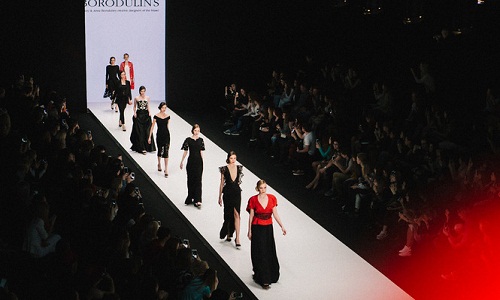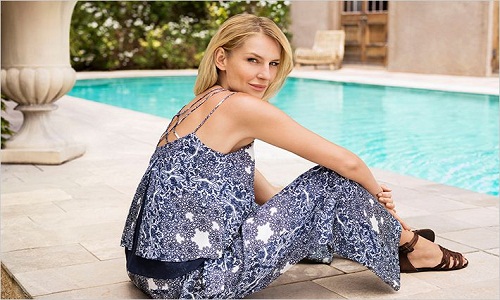FW
"Fashion Futurum International Сonference aims to develop a new approach to fashion in Russia. The Conference is a platform for both Russian and international industry leaders, visionaries and key fashion players who share their experiences and views on the current state of fashion industry around the world and its role as a driver of creative economy."

Fashion Futurum International Сonference aims to develop a new approach to fashion in Russia. The Conference is a platform for both Russian and international industry leaders, visionaries and key fashion players who share their experiences and views on the current state of fashion industry around the world and its role as a driver of creative economy.
On March 16-17 2017 over 30 world fashion industry leaders from 9 countries will meet in the very center of Moscow to discuss contemporary trends and main challenges of the industry. Fashion Futurum 2017 is devoted to the transformation of the fashion industry under the impact of scientific and technological revolution. Fashion Futurum's visioners will address the theme of confrontation between new media and glossy magazines, changing consumer behavior, e-Commerce features, the phenomenon of eco fashion world and other trends of fashion industry.
The sessions of the day 1:
1. Future Jobs in Fashion: Fashion Professions Foresight, Expectations and Requirements
2. VR-commerce: will Virtual and Augmented Reality Affect E-Commerce in Fashion?
3. Modern Craftsmanship: Merging Technology and Fashion
4. Fast Production for High-End Fashion: How Does It Change the Industry?
5. Smart Materials and Smart Innovations: The Future of Fashion
6. Fashion’s Next Frontier: Smart Clothing for People with Disabilities
7. Talent Scouting in the Fashion industry
8. Perfect Storm: Technology Disruption in the Value Chain
9. Fashion is Next Hot Spot for Investments
10. Why Retailers Should Have an Innovation Program?
11. Incubation of Fashion Tech: Global Experience
12. The End of the Glossy Era: How New Media Drive Sales in Fashion
13. Future of Sourcing in Fashion
14. System Disruption: Do Fashion Weeks Have a Future?
Key speakers of the day:
SYLVIE EBELExecutive Director, L’Institut Francais de la Mode (France)
DANILO VENTURIDean, Polimoda (Italy)
COVADONGA O’SHEA Founder, ISEM Fashion Business School, best-selling author (Spain)
TATIANA RIVCHUN Moderator, Associate Dean, School of Design, Higher School of Economics (Russia)
CRAIG AREND VR/AR expert, Founder of AltamiraNYC (USA)
DAVID MONTEITH Fashion & Apparel Director, Flextronics (USA)
MARK JARVIS Managing Director, World Textile Information Network (UK)
GEOFFREY WILLIS CEO, Trigon Select Ltd (UK)
SVETLANA ANDRIANOVA President, Company FARADEI CJSC (Russia)
FILIPPO CERONI CEO, Grazia Bagnaresi (Italy)
EVGENY KOVNIR Moderator, Deputy Director, Young Professionals, ASI (Russia)
GIUSY BETTONI CEO, C.L.A.S.S. Eco Textile Library (Italy)
DAVID MONTEITH Fashion & Apparel Director, Flextronics (USA)
AMANDA PARKES Chief of Technology & Research, Manufacture NY (USA)
DMITRY KOLOBOV Head of Department of Socially Important Products, Ministry of Industry and Trade (Russia)
SERGEY KARNAUKHOV Moderator, Head, Alliance of Russian Art Engineers, Associate Professor, RANEPA (Russia)
GIULIA PIROVANO Group Market Director, Istituto Marangoni (Italy)
MARK JARVIS Managing Director, World Textile Information Network (UK)
JEFFRY ARONSSON Founder and CEO, Aronsson Group LLC (USA)
ALEXANDER KORCHEVSKY Partner, I2BF Global Ventures (Russia)
IRINA DYADUYNOVA Executive director, Russian Fashion Counsil (Russia)
KIRILL TISCHENKO Moderator, Investment Dept., Skolkovo foundation (Russia)
ALEXANDR GALITSKIY SCOTT EMMONS Head of the Innovation Lab, Neiman Marcus (USA)
ANDREY DEYNEKO DON LIM Center for Creative Economy and Innovation (South Korea)
GARY STEWART Director, Wayra (UK)
EKATERINA INOZEMTSEVA Moderator, Vice-President of Skolkovo Foundation (Russia)
MICHAEL BURKE Head of Industry, Fashion, Sports & Toys, Google (USA)
ALEXEY BAZHENOV Moderator, Founder of Be-in.ru DR. CLAUDIO D. MARTELLICOO, Trigon Select Ltd (UK)
PASCAL MORAND Executive President, French Federation of the Haute Couture and Pret-a-porter (France)
XIAOLEI LV Vice Secretary General, Shanghai Fashion Week (China)
ALEXANDER SHUMSKY Executive President, Russian Fashion Council (Russia)
The sessions of the day 2:
1. Protecting Intellectual Property in Fashion Industry on Global Markets
2. IT Solutions and Mobile Apps for Fashion Brands: Is It a Game Changer for Fashion Business?
3. Brand protection measures 4. Sustainability: Ethical Fashion Rules the World
5. The Future of Design. Fashion is Included 6. Fashion is Next Hot Spot for Investments
7. The Cross-Border Market Opportunity: Today’s Growth Rocket 8. Only Designers Will Stay: Creative Future of The Fashion Industry
9. The Winning Model of Spanish Fashion Industry
10. Upgrading Traditional Retail: Creating a Fluid Shopping Experience
11. Acceleration Models for the Fashion Industry
12. Local Becomes Global: How National Brands Can Succeed on the Global Marketplace
13. A FashionTech Start-up is Just a Start-up: What Rules to Follow and What to Break
14. Italian Young Designers Say CIAO! to the Fashion System
Key speakers of the day:
ALBERTO CRIVELLIPartner, AMTF Avvocati (Italy)
LUDMILA NOVOSELOVA Chairman of Intellectual Rights Court, Doctor of Law (Russia)
EVGENY PEN CEO, Intellectual Property Depositary (Russia)
MAKSIM DYSHLYUK EDDIE MULLON CEO of Launchmetrics, Founder of Fashion GPS (USA)
VICTORIYA PAVLOVA GIUSY BETTONI CEO, C.L.A.S.S. Eco Textile Library (Italy)
PIIA LEHTINEN President of the Board, Design District Helsinki (Finland)
MARINA KOKORINA President, RusEcoModa (Russia)
COVADONGA O’SHEA Moderator, Founder, ISEM Fashion Business School, best-selling author (Spain)
KARIM RASHID Designer (USA)
MARVIN LIAO Partner, 500 Startups (USA)
AMANDA PARKES Chief of Technology & Research, Manufacture NY (USA)
EDDIE MULLON CEO of Launchmetrics, Founder of Fashion GPS (USA)
KONSTANTINE KARCZMARSKI Moderator, Advisor to Innovations Department, ITMO University (Russia)
ANNA KLINSKOVA Vice-President Sales and Marketing, DHL Express (Russia)
OKSANA SHPITALNIKOVA DHL Express (Russia)
ALEXANDER KIBOVSKY Minister of Government of Moscow, Head of Department of Culture, Moscow Government (Russia)
KARIM RASHID Designer (USA)
PRINCESS BEATRICE D’ORLEANS President of the Spanish Luxury Association, Ambassador of Dior (Spain)
DMITRY PESKOV Director, Young Professionals, ASI (Russia)
ALEXANDER SHUMSKY Moderator, President, Russian Fashion Council (Russia)
CARLOS ESPINOSA DE LOS MONTEROS High Government Commissioner for the Spain Brand,Vice-President of Inditex (Spain)
ALEXEY BAZHENOV Moderator, Founder of Be-in.ru MICHAEL BURKE Head of Industry, Fashion, Sports & Toys, Google (USA)
SCOTT EMMONS Head of the Innovation Lab, Neiman Marcus (USA)
ALLA VERBER Vice-President, Mercury Russia, Fashion Director, TSUM Department Store (Russia)
ANNA KLINSKOVA Vice-President Sales and Marketing, DHL Express (Russia)
ARINA SLYNKO GARY STEWART Director of Wayra (UK)
EKATERINA SHAKINA Head of Projects, ASI (Russia)
VICTOR EVTUHOV State Secretary, Deputy Minister of Industry and Trade of the Russian Federation
CARLOS ESPINOSA DE LOS MONTEROS High Government Commissioner for the Spain Brand, Vice-President of Inditex (Spain)
JEFFRY ARONSSON Founder & CEO, Aronsson Group LLC (USA)
PASCAL MORAND Executive President, French Federation of the Haute Couture and Pret-a-porter (France)
IGOR BARTSITS Moderator, Director of IPACS, RANEPA (Russia)
MARVIN LIAO Partner, 500 Startups (USA)
ELENA PRIVALOVA OLIVIA SPINELLI Fashion Coordinator at IED Moda Lab, Istituto Europeo di Design
GIORGIA LAURETI & PARISI LUCIANO IED Milan Graduates
OLGA MYELKOVA IED Group Area Manager
Vietnam’s textiles export earnings in the first six months of this year rose 10.26 per cent compared to the same period last year says Vietnam National Textile and Garment Group (Vinatex). The US, South Korea and the European Union were the biggest importers of Vietnamese products, posting growth rates of 11.01 per cent, 8.33 per cent, and 8.2 per cent against the same period last year.
Vietnam is the fourth largest textile exporter in the world. The sector will need to make additional efforts to seek new markets and opportunities, and establish partnerships with major groups to be able to sign high-value orders in the remaining months of this year.
Vietnam’s leather and footwear industry expects to raise its export value by 10 per cent this year. Footwear currently ranks fourth and suitcase-bag-briefcase ranks tenth among Vietnam’s top ten foreign currency earners. To achieve the target, the leather and footwear sector needs to boost technological innovation, invest in new equipment and modernise existing equipment, expand the production scale of domestic enterprises to increase productivity as well as improve the quality of products.
Another promising element is the Vietnam-European Union free trade agreement, which will take effect in 2018 and afford Vietnamese footwear makers more opportunities to boost exports.
The textile sector in India contributes more than five per cent to India’s GDP and 14 per cent to overall index of industrial production. The sector is expanding even though it has been facing numerous challenges. The sector comprises small-scale, medium-scale, large-scale, non-integrated, spinning, weaving, finishing, and apparel-making firms and enterprises.
The textile and apparel industry is broadly divided into three segments. One, yarn and fiber (including natural and manmade), mainly made up of cotton and jute; second, processed fabrics (including woolen textiles, silk textiles, jute textiles, cotton textiles and technical textiles); and third readymade garments and apparel.
The unorganized sector includes handlooms, power looms, hosiery, knitting, readymade garments, khadi, carpets and handicraft manufacturing units. The organized mill sector comprises spinning mills and composite mills where spinning, weaving, and processing activities happen.
Exports of Indian textile and apparel products have been growing with the EU and the US as major export destinations. The basic strength of the industry in India is its strong production base of a wide range of natural fibers like cotton, jute, silk and wool to synthetic or manmade fibers like polyester, viscose, nylon and acrylic.
Overall production of manmade filament yarn has declined over the last few years, though production of viscose filament yarn and nylon filament yarn has increased correspondingly.
German clothing retailer C&A is examining partnerships and other types of outside investment as it develops a turnaround plan focusing on China and other emerging markets. Swiss-based COFRA Holding issued a statement in response to a report in Spiegel Online that C&A, which was founded in the 19th century and remains in family ownership, was close to being sold to a group of unnamed Chinese investors.
The company is committed to a successful, future-proof C&A business and as such at C&A it has embarked on a transformation and growth programme, says a COFRA Holding representative. The ongoing transformation of C&A includes an investigation of ways to accelerate in high growth priority areas. These included “China, emerging markets that could potentially include partnerships and other types of additional external investment.
C&A was founded as a confectionery business in 1841 by brothers Clemens and August Brenninkmeyer, and today runs more than 1,500 stores, employs 35,000 people and operates in 18 European countries. The business, controlled via COFRA by more than 1,000 descendants of the Brenninkmeyers, has struggled of late to compete with fast-fashion brands and online retailers. Caparros, formerly of German supermarket chain REWE, was hired as chief executive of C&A in mid-2017, replacing Philippe Brenninkmeijer in a break from the tradition of a family member running the company.
India may have a uniform unit of weight for cotton trade. One recommendation is buying should be in kilos or tons only since this would make pricing accurate. The step is a move towards more uniformity and transparency in the cotton trade. Different units of weight cause ambiguity and confusion for the exporters, who have to plan their purchases. Export orders have a plus or minus five per cent variation in the weight and one isn’t sure exactly how much cotton will be there in a bale — 160 kg or 165 kg.
So far, cotton has been traded in different weight units at different parts of the value chain in different growing regions in the country. Gujarat, the largest cotton producer, uses bales for cotton procurement from markets while kapas (raw, unginned cotton) is weighed in quintals. Ginned cotton is quoted in candies.
While farmers get the price based on quintal weight, the procurement at the market or mandis is quoted in bales. Nowhere in the world is cotton procurement quoted in bales. While the weight in India has been fixed at 170 kg for a bale, many states still have bales with 160 to 165 kg. Ginned cotton is quoted in candy, while exports take place in terms of tons.
Bangladesh wants to have stronger trade links with Hong Kong. Leveraging on Hong Kong’s intrinsic geographic and economic advantages, Bangladeshi companies can expand businesses into the Chinese mainland and the world using this value-adding gateway. Bangladesh hopes to trade with Hong Kong in readymade garments, leather, textiles, fabrics, food, sea food, frozen foods, jute and ceramic products.
The total trade value between Bangladesh and Hong Kong amounted to nearly $1.7 billion in 2016. Hong Kong sees Bangladesh as a market with great potential for uncovering bilateral opportunities. It sees Bangladesh as a manufacturing powerhouse in South Asia with a rapidly expanding economy, and an important partner on the Bangladesh-China-India-Myanmar economic corridor under the Chinese mainland’s belt and road initiative.
Trade fairs that offer one-stop marketing and sourcing platforms present prime opportunities for Bangladeshi traders to gather the latest market intelligence and form partnerships and develop their business in Hong Kong. Hong Kong is presenting itself as a sourcing and distribution hub in Asia.
Many garment, leather and footwear factories in China want to relocate production units to Bangladesh to utilise duty-free entry benefits allowed to exports. These companies want to manufacture in Bangladesh and re-export the finished products to the world through Hong Kong.
"Every year, 100 million tons of new textiles come into the market and the textile industry has one of the highest turnovers in the world. It has long been understood that textile production has major environmental impact. But it has been difficult for textile companies to determine what choices they can make to reduce the environmental load, due to the wide variation in production processes."

Every year, 100 million tons of new textiles come into the market and the textile industry has one of the highest turnovers in the world. It has long been understood that textile production has major environmental impact. But it has been difficult for textile companies to determine what choices they can make to reduce the environmental load, due to the wide variation in production processes.

Researcher Sandra Roos has taken an overall approach to the clothing life cycle with her Swedish research reveals interesting facts doctoral thesis at Chalmers University of Technology in Sweden and the research institute Swerea, within the research program Mistra Future Fashion. Over the course of her five-year project, she studied 30 different sub-processes in textile production. She assessed toxicity of the chemicals used in the processes. The sub-processes studied extend from techniques as different as entirely synthetic textile fibres made of plastic, to cotton production – where farmers cultivate the soil, plant and harvest the cotton, before ginning and preparing it.
Collaborating for sustainability
Mistra Future Fashion is a collaborative project between the fashion industry and researchers in Sweden. Their next step will be to transform the results of the thesis to a practical tool that clothing manufacturers can use to improve the environmental performance of their processes and products. The tool is expected to be ready sometime in 2017. This is an important step, since the majority of the environmental load in the clothing life cycle is created in the production phase.
Roos's research shows conventional cotton growing, where large quantities of insecticides are spread directly on land, stands out as a particularly heavy burden on the environment. At present, most environmental indices are based on the type of textile fibre used: wool, nylon, polyester or cotton. But that is not where the major environmental impact is found, which is actually in the post-fibre processing stages: spinning, weaving, knitting and, above all, in the dyeing – the wet processing. All chemicals used in these processes actually make it hazardous as cotton growing.
Usability quotient
To be eco-friendly clothes need to be used until they are worn out. That is more important than all other aspects, such as how and where the clothes were manufactured and the materials they are made of. But in industrialised countries, only a tiny percentage of garments are worn 100 to 200 times, which is usually the potential lifetime. In Sweden, for example, consumers buy an average of 50 new garments per person in a year. It is difficult for consumers to get information about the most important aspects – those related to processing of the textile materials.
Textiles are made of cellulose from trees and plants are an important track in research and development to close the loop so that the textile industry becomes sustainable. Viscose, modal and lyocell/Tencel are examples of such textiles that are already available and whose environmental performance is often good.
Eco-labelled clothing
Buying eco-labelled clothes makes a difference. There are several cotton labels, including BCI (Better Cotton Initiative) and GOTS. However, eco-cotton labels only indicate that the cotton was organically grown – they say nothing about the rest of the production process (dyeing and treatment). On-line shopping is generally a very good alternative from the environmental perspective. But only if you do not end up buying clothes you like less – and hence wear less – or returning lots of garments. E-retailers do not always put returned garments back in stock to be sold again.
Australia’s wool exports are forecast to rise by four per cent in 2017–18. Wool demand will continue to grow in the European Union and the US, the major international markets for imported woolen clothing. Demand for luxury woolen textiles is rising in major international markets especially China.
Australian wool prices are forecast to rise eight per cent in 2016-7. Prices are expected to peak next year before easing in real terms as wool production increases. And, by the end of 2021-22, prices are expected to still be relatively high, at around ten per cent above the ten-year average in real terms.
The upward trend in prices reflects the constrained supply of apparel wool—given lower flock numbers—and firm demand, particularly for fine wool. The continuing growth in wool demand has led to an increase in the price of wool in Australian dollars since 2014.
By the end of 2016-17, shorn wool production is forecast to be five per cent higher than last year, reflecting flock rebuilding across the sector supported by good pasture growth on the back of the 2016 rainfall. And the national sheep flock is forecast to increase to 73.6 million heads in 2016-17 and to continue increasing to around 83 million heads by 2021-22.
Corporate Human Rights Benchmark has ranked apparel companies in the world on human rights issues. Marks & Spencer and Adidas figure high followed close behind by H&M, Gap, and Nike. At the bottom of the pile are Kohl's, Macy's, Walmart, Under Armor and Fast Retailing.
Businesses were assessed on human rights policies, governance, processes, practices and transparency as well as how they respond to serious allegations. CHRB aims to make corporate human rights performance easier to see and simpler to understand for a wide range of audiences - inside and outside companies.
Leading companies are those that have recognised the moral imperative, business case, and commercial viability of taking action on human rights. There are a large proportion of companies that are performing poorly, with an average score per measurement theme of between 20 and 29 per cent. Thirteen out of the 30 apparel companies assessed fall in this category. These low performing companies spell dangers of human rights abuse of workers.
In the CHRB's apparel industry criteria, the highest scoring area was transparency, followed by policy, with companies scoring lowest in remedies and grievance mechanisms. The main finding is that many companies are yet to implement the UN guiding principles and other internationally recognised human rights and industry standards.
Bangladesh’s garment exports to non-traditional markets increased 3.4 per cent year-on-year in July-December of the current fiscal year. For Bangladesh, non-traditional markets are those other than the European Union, US and Canada. Of the non-traditional markets, Bangladesh’s garment exports to Japan registered the highest growth in the July-December period. Japan is the biggest export destination for Bangladesh in Asia. Apparel exports to Japan rose 6.55 per cent.
Japan wants to reduce its dependence on China. Right now more than 80 per cent of Japan’s apparel imports are from China. The country is looking at Bangladesh as an alternative. Other promising non-traditional markets for Bangladeshi garments are Russia, Australia and China.
Bangladesh began giving cash incentives on garment exports to emerging markets to offset the fallout from the global financial meltdown in 2007. These cash incentives on export to non-traditional markets drove growth over the years.
Subsequently, exports to India, China, Russia, Japan, South Africa, Turkey, Brazil, Chile, Mexico, South Korea, Malaysia, Australia and New Zealand started to rise. The cash incentive for apparel exporters was five per cent in 2009-10, four per cent in 2010-11 and two per cent in 2011-12. They still receive a two per cent incentive for exports to new destinations.












